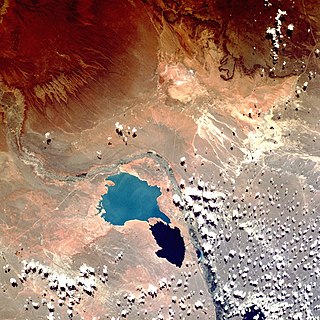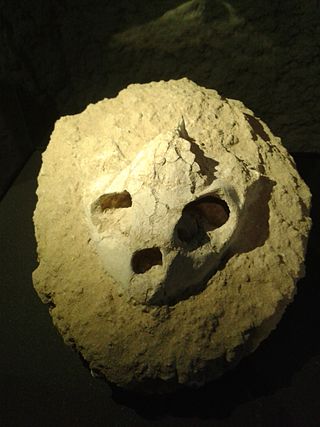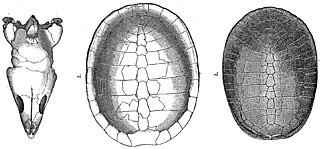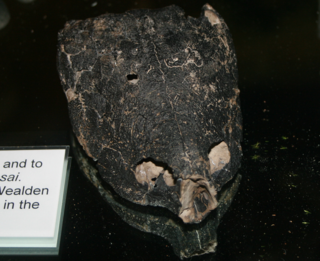Paracimexomys is a genus of extinct mammals in the also extinct Multituberculata order. Paracimexomys lived during the Cretaceous period. The few fossils remains come from North America. Some Romanian fossils were also tentatively assigned to this genus, though that classification now seems doubtful.
Mesodma is an extinct genus of mammal, a member of the extinct order Multituberculata within the suborder Cimolodonta, family Neoplagiaulacidae. It lived during the upper Cretaceous and Paleocene Periods of what is now North America. The earliest definitive record is from the late Santonian stage strata of the Straight Cliffs Formation. A single premolar tooth from the lower Cenomanian stage strata of the Cedar Mountain Formation has been tentatively assigned to this genus based on its similarity, but its describers noted that it is unlikely that Mesodma lived during that time.

Chelidae is one of three living families of the turtle suborder Pleurodira, and are commonly called Austro-South American side-neck turtles. The family is distributed in Australia, New Guinea, parts of Indonesia, and throughout most of South America. It is a large family of turtles with a significant fossil history dating back to the Cretaceous. The family is entirely Gondwanan in origin, with no members found outside Gondwana, either in the present day or as a fossil.

Squalicorax, commonly known as the crow shark, is a genus of extinct lamniform shark known to have lived during the Cretaceous period. The genus had a global distribution in the Late Cretaceous epoch. Multiple species within this genus are considered to be wastebasket taxon due to morphological similarities in the teeth.

Sauroposeidon is a genus of sauropod dinosaur known from several incomplete specimens including a bone bed and fossilized trackways that have been found in the U.S. states of Oklahoma, Wyoming, and Texas.

Tenontosaurus is a genus of medium- to large-sized ornithopod dinosaur. It was a relatively medium sized ornithopod, reaching 6 to 7 meters in length and 600 to 1,000 kilograms in body mass. It had an unusually long, broad tail, which like its back was stiffened with a network of bony tendons.

The Neuquén Group is a group of geologic formations found in Argentina. Rocks in the Neuquén Group fall within the Cenomanian to early Campanian stages of the Late Cretaceous Period. It overlies the older Lohan Cura Formation and is itself overlain by the younger Allen Formation of the Malargüe Group, separated from both by unconformities, dated to 98 and 79 Ma respectively.

The Cloverly Formation is a geological formation of Early and Late Cretaceous age that is present in parts of Montana, Wyoming, Colorado and Utah in the western United States. It was named for a post office on the eastern side of the Bighorn Basin in Wyoming by N.H. Darton in 1904. The sedimentary rocks of formation were deposited in floodplain environments and contain vertebrate fossils, including a diverse assemblage of dinosaur remains. In 1973, the Cloverly Formation Site was designated as a National Natural Landmark by the National Park Service.

Bothremydidae is an extinct family of side-necked turtles (Pleurodira) known from the Cretaceous and Cenozoic. They are closely related to Podocnemididae, and are amongst the most widely distributed pleurodire groups, with their fossils having been found in Africa, India, the Middle East, Europe, North America and South America. Bothremydids were aquatic turtles with a high morphological diversity, indicative of generalist, molluscivorous, and piscivorous diets. Unlike modern pleurodires, which are exclusively freshwater, bothremydids inhabited freshwater, marine and coastal settings. Their marine habits allowed bothremydids to disperse across oceanic barriers into Europe and North America during the early Late Cretaceous (Cenomanian). The youngest records of the group are indeterminate remains from Saudi Arabia and Oman, dating to the Miocene.

Peirosauridae is a Gondwanan family of mesoeucrocodylians that lived during the Cretaceous period. It was a clade of terrestrial crocodyliforms that evolved a rather dog-like form, and were terrestrial carnivores. It was phylogenetically defined in 2004 as the most recent common ancestor of Peirosaurus and Lomasuchinae and all of its descendants. Lomasuchinae is a subfamily of peirosaurids that includes the genus Lomasuchus.

Glyptops is an extinct genus of pleurosternid freshwater turtle known from the Late Jurassic of North America.
The Magallanes Basin or Austral Basin is a major sedimentary basin in southern Patagonia. The basin covers a surface of about 170,000 to 200,000 square kilometres and has a NNW-SSE oriented shape. The basin is bounded to the west by the Andes mountains and is separated from the Malvinas Basin to the east by the Río Chico-Dungeness High. The basin evolved from being an extensional back-arc basin in the Mesozoic to being a compressional foreland basin in the Cenozoic. Rocks within the basin are Jurassic in age and include the Cerro Toro Formation. Three ages of the SALMA classification are defined in the basin; the Early Miocene Santacrucian from the Santa Cruz Formation and Friasian from the Río Frías Formation and the Pleistocene Ensenadan from the La Ensenada Formation.

Tempskya is an extinct genus of tree fern that lived during the Cretaceous period. Fossils have been found across both the Northern and Southern hemispheres. The growth habit of Tempskaya was unlike that of any living fern or any other living plant, consisting of multiple conjoined dichotomous branching stems enmeshed within roots that formed a "false trunk".
Rugocaudia is a potentially dubious genus of basal titanosauriform sauropod dinosaur known from the Early Cretaceous of Montana, United States.

Maimetshidae is an extinct family of wasps, known from the Cretaceous period. While originally considered relatives of Megalyridae, they are now considered to probably be close relatives of Trigonalidae.

Macrobaenidae is an extinct family of turtles, known from the Early Cretaceous to Paleogene of Laurasia. Their relationships to other turtles and whether or not they form a monophlyletic group are controversial. They are typically interpreted as stem or crown group cryptodires, but some more recent analyses have found them to lie outside crown group Testudines. Macrobaenids can be distinguished from other testudinatans by the presence of a carotid fenestra, cruciform plastron with strap-like epiplastra, and a lack of extragulars.

Sinemydidae is an extinct family of turtles from Cretaceous to Paleocene deposits in Asia and North America. Their exact position is engimatic, they have alternatively been considered stem-group cryptodires, but also "crownward stem-turtles" alongside Macrobaenidae, Paracryptodira, Xinjiangchelyidae, Thalassochelydia and Sandownidae outside of crown Testudines.

The Helochelydridae are an extinct family of stem-turtles known from fossils found in North America and Europe spanning the Early to Late Cretaceous.
Patagosuchus is an extinct genus of peirosaurid crocodyliform known from the early Late Cretaceous Portezuelo Formation of Neuquén Province, western central Argentina. It contains a single species, Patagosuchus anielensis. It is distinguished from other peirosaurids by its extremely heterodont dentition, which includes small serrated teeth at the front of the jaws with much larger, laterally compressed caniniform teeth behind them. Patagosuchus also has large spaces between its teeth called interalveolar spaces that are not found in any other peirosaurid.
Timeline showing the development of the extinct reptilian order Pterosauria from its appearance in the late Triassic period to its demise at the end of the Cretaceous, together with an alphabetical listing of pterosaur species and their geological ages.
















